SB Television
Sailing Japan: A Voyage of Friendship and Discovery
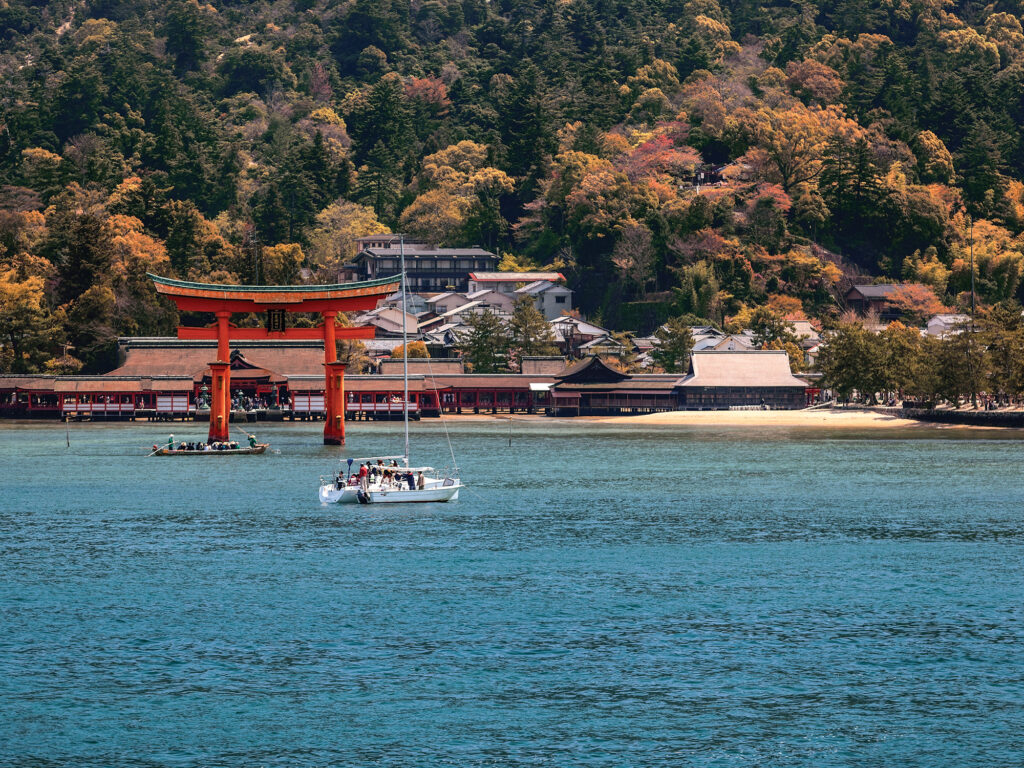 The sacred red torii gate marks the threshold between the human world and the spiritual, a timeless symbol of Japan’s deep cultural heritage.
kekyalyaynen/stock.adobe.com
The sacred red torii gate marks the threshold between the human world and the spiritual, a timeless symbol of Japan’s deep cultural heritage.
kekyalyaynen/stock.adobe.com
Our 1969 Cross 46 trimaran, Migration, was assigned an extra-wide guest dock at Fukuoka’s Odo Marina on the island of Kyushu. Strong northwest winds were in the forecast, so we began tying lines together to reach 65 feet across to the opposite finger.
That’s when Choichi-san wandered over. He’s a classic salt we’d met months earlier in Yakushima, where we shared a quay while waiting out a gale. He’d wasted no time showing us tricks for mooring to the barnacle-crusted walls of Japanese fishing harbors. And now, here he was again, appearing as if by magic to lend a hand—this time with a brand-new, ¾-inch braided line, long enough to keep Migration clear of the dock.
When the blow had passed and we offered to return the line, Choichi-san declined, saying, “No, no. For you.” We think of him every time we use it.
That mooring line was the first of many gifts we received with no expectation of anything in return. In fact, we soon discovered the difficulty of giving thank-you gifts in Japan, often finding ourselves on the receiving end of a thank-you-for-the-thank-you gift.
But it was the friendships, not the gifts, that made our time in Japan so memorable. We’ve met all kinds of people during 20 years of cruising in 28 countries, but the Japanese were the epitome of hospitality. Their friendship, generosity and excitement for our visit overwhelmed us.
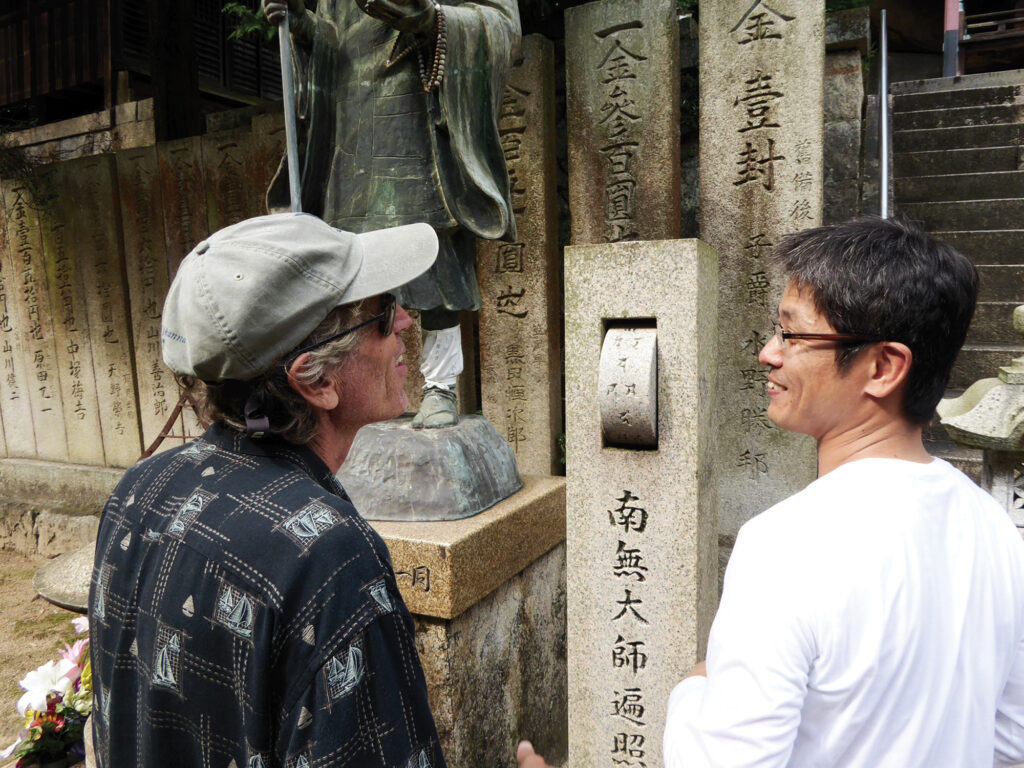 At a hillside temple, Bruce shares a moment with our good friend Yoshi, whose unfiltered enthusiasm for sailing made every reunion in Japan a celebration.
Bruce Balan, Alene D. Rice
At a hillside temple, Bruce shares a moment with our good friend Yoshi, whose unfiltered enthusiasm for sailing made every reunion in Japan a celebration.
Bruce Balan, Alene D. Rice
Both of us had dreamed of sailing to Japan, especially because Migration was built there 56 years ago. She was shipped to her first owner in California, where she was berthed in Alamitos Bay Marina—on the same bay where a 12-year-old Bruce was learning to sail dinghies. During a two-year refit in Thailand, we stripped away her delaminating fiberglass (polyester resin doesn’t age well on plywood). Underneath, we found handwritten kanji, a system of Japanese writing that uses Chinese characters. Photos of this delighted nearly everyone we met in Japan. A boat like Migration was a rare sight, and the idea that she was a product of decades-old Japanese craftsmanship fascinated many people we encountered.
In early June, we arrived in Ishigaki, at the southern end of the Ryukyu Islands, after a 28-hour sail from Taiwan. Eleven officials from six departments processed our arrival, a long but impeccably polite affair. We spent the next 10 days getting our bearings: securing a SIM card (a multiday challenge), completing paperwork, diving with manta rays, visiting nearby islands and savoring our first exceptional Japanese meal.
Eventually, we set sail for Teramajima, 35 nautical miles to the northeast, where we met our first tomodachi, or friend. The island has just 1,000 residents, and the sun was blistering as we walked through farmlands toward the village. We spotted a man with a group of children and asked in basic Japanese where we might find ice cream. To our surprise, he replied in English. Yoshi-san, from Kobe, turned out to be the only other tourist on the island.
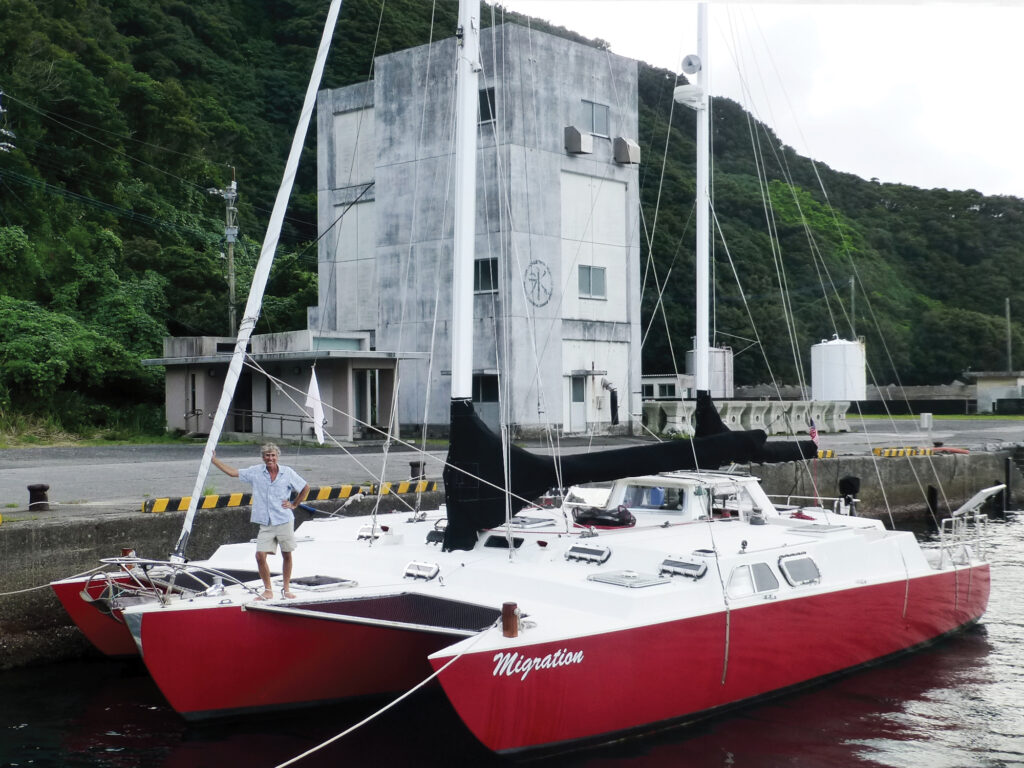 Riding out a gale in Yakushima’s Isso Ko harbor, Migration rests as wind and spray sweep the rugged island.
Bruce Balan, Alene D. Rice
Riding out a gale in Yakushima’s Isso Ko harbor, Migration rests as wind and spray sweep the rugged island.
Bruce Balan, Alene D. Rice
His warmth and enthusiasm were instant. When he told us he was taking the ferry to Miyako-jima in two days—the same day we planned to sail there—we invited him to join us. “Sugoi!” he shouted, jumping up and down and making the kids giggle. It was, indeed, amazing. We’d never seen such unfiltered excitement after an invitation to sail aboard our boat.
The 30-mile sail was lively, with 25 knots on the quarter. Yoshi-san patiently answered our endless grammar questions until, mid-sentence, he leaned over the coaming, threw up and turned back to finish his answer. A true trouper.
We moored in Miyako-jima’s fishing harbor, and Yoshi headed to his friends’ guesthouse, promising to return later. When we arrived that evening, we were greeted by birthday decorations, food, new friends and a cake—a celebration in honor of Alene’s recent birthday. The beer and awamori flowed late into the night. It was an unforgettable (and slightly soused) introduction to Okinawan hospitality.
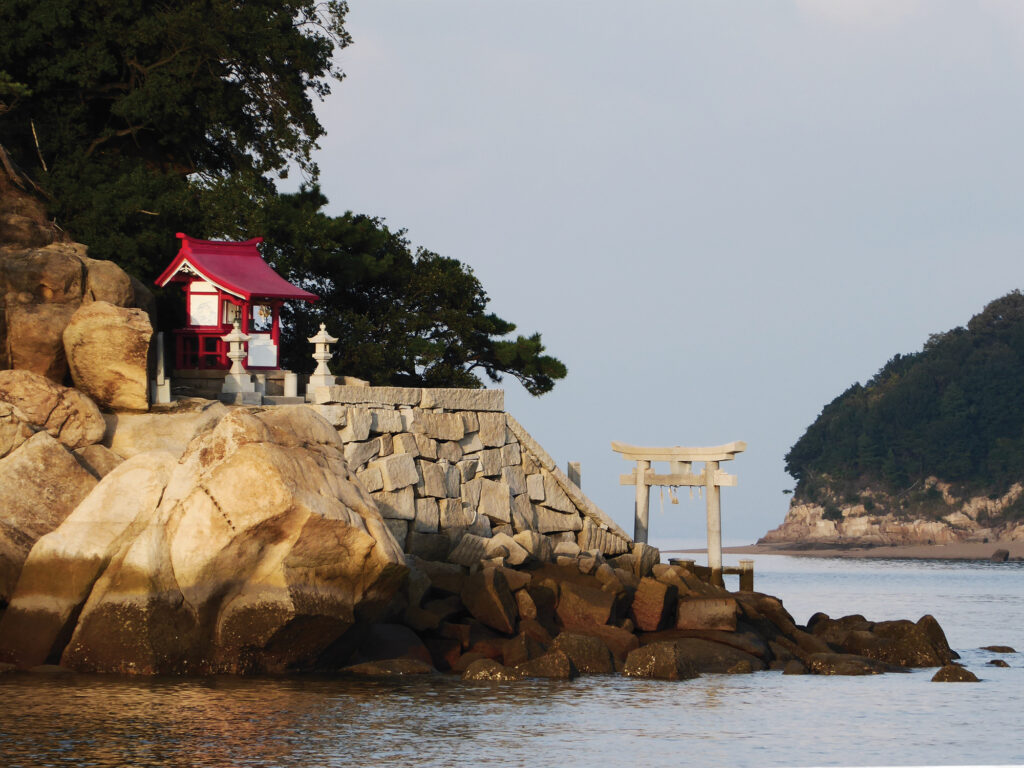 A shrine beside our anchorage on Shiraishishima glows in the golden light of sunset, its torii gate and lanterns a tranquil welcome after a day under sail.
Bruce Balan, Alene D. Rice
A shrine beside our anchorage on Shiraishishima glows in the golden light of sunset, its torii gate and lanterns a tranquil welcome after a day under sail.
Bruce Balan, Alene D. Rice
As we sailed north through the Ryukyu Islands, the snorkeling proved superb. Tokashiki and Zamami had stunning coral, colorful fish and tranquil anchorages. At Kakeromajima, after snorkeling a small reef, we swam ashore to a beach that was deserted, except for three people lounging on a blanket. They waved us over, and though our Japanese faltered, we understood they wanted us to wait. Soon, the fourth of their party arrived.
Nob-san is a tall man who carries himself with an almost regal elegance. Thankfully, he also speaks English. His wife, Keichan, was born on the island, and they often returned from Yokohama with their friends, Kiyoshi-san and Mieko-san. We were invited to a picnic, which turned into a sail and snorkeling trip aboard Migration. That first meeting blossomed into a decade-long friendship full of rich political and philosophical conversations through email exchanges.
We continued into the Seto Inland Sea via the narrow, bustling Kanmon Strait, just as the Setouchi Triennale art festival was underway. The chance to sail from island to island, taking in installations both quirky and profound, felt like a stroke of luck.
New friends marked nearly every port. One of the most surreal encounters occurred in Hiroshima. We’d met Mitsugi-san, a surgeon, in Fukuoka. He told us to call if we ever sailed to Matsuyama, his hometown. When we did, he hosted us for a tour of a historic mountain village and told us he hadn’t sailed in years. Naturally, we invited him for our next leg: a 35-mile hop to Hiroshima.
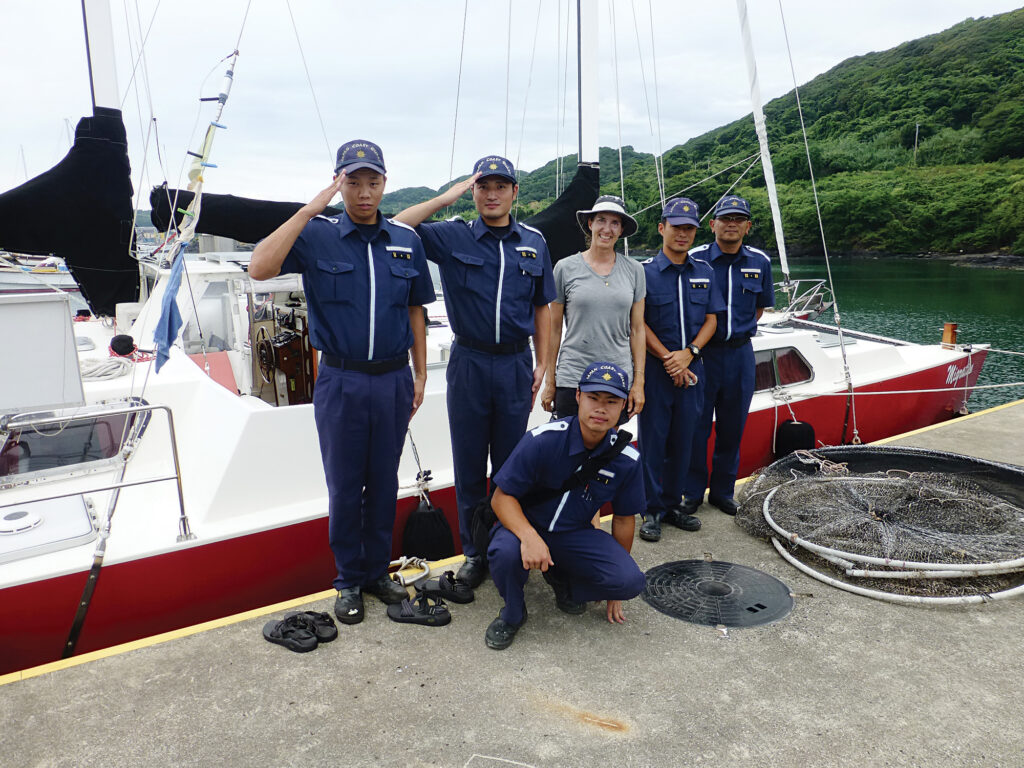 While waiting out a typhoon in Iki Shima, an expired port permit brought an unexpected but friendly visit from the Japanese Coast Guard.
Bruce Balan, Alene D. Rice
While waiting out a typhoon in Iki Shima, an expired port permit brought an unexpected but friendly visit from the Japanese Coast Guard.
Bruce Balan, Alene D. Rice
It was a brisk, cold sail, but Mitsugi-san relished every moment, especially steering between islands. Upon arrival at Hiroshima’s Kanon Marina, we assumed we were off to enjoy local okonomiyaki. Instead, we sat in a dentist’s waiting room for an hour. Enter Misato-san, a whirlwind of energy and conversation who whisked us away on a series of cryptic errands in her enormous Cadillac, music blaring. Eventually, we got our okonomiyaki. Then, after dropping off Mitsugi-san, we picked up her husband and a stack of towels. Off we sped into the mountains to a beautiful onsen.
These public baths fed by hot springs are a cornerstone of Japanese life. We adored them. That night, Alene received an enthusiastic, nonstop tutorial on bathing etiquette from Misato-san. Bruce, meanwhile, enjoyed quiet soaking time with her husband.
By the time we returned to Migration, well past midnight, we were exhausted and dazed. What began as a routine day sail had become a full-blown, unforgettable adventure.
Japan is breathtaking. But more than anything, the friendships shaped our experience and made each moment feel dreamlike.
Every port held surprises: In Kobe, we reunited with Yoshi-san and spent nights in his favorite bar, playing music and making friends. In Shōdoshima, we sang Christmas carols with Maya, Yuki and her rabbit, which was dressed as Santa Claus. In Nagasaki, Tatsuo-san and Keiko-san insisted we join them for a beach day the moment we tied up.
Japan is breathtaking: misty cedar forests, turquoise seas, snowy pine-covered peaks. Its architecture is graceful, its food sublime, and its culture intricate and endearing. But more than anything, the friendships shaped our experience. They lifted us, carried us and made each moment feel dreamlike.
Migration was welcomed back to her birthplace. And we were embraced by friends who touched our hearts and continue to call us back.
Bruce Balan and Alene D. Rice have been sailing full time aboard Migration since 2005 and are the creators of TheChartLocker.com. They are in New Zealand and plan to return to Japan in 2027. Follow them at svMigration.com.
Tips for Cruising in JapanRespect the CultureJapan has many social nuances. One example is chotto muzukashii, which means “a little difficult.” Usually, if someone says something is a little difficult, my response is, “Well, let’s figure out how to do it.” But in Japan, the phrase means “it cannot be done,” as it’s considered rude to say a direct no. § Being considerate, polite and respectful will take you much farther than being loud or pushy. We cannot stress enough how important this is. Already, several marina operators are considering excluding foreign boats because of bad behavior. In Japanese society, you must avoid inconveniencing others, even unintentionally. Your actions will affect how all future cruisers are received.
LanguageIt can seem an insurmountable challenge to learn a language as different from English as Japanese. But since many Japanese people are shy, learning a little will help break the ice. Everyone we met was extremely grateful for our attempts to speak the language. § There are three alphabets used in Japan. We recommend learning Katakana first, as that is the alphabet used for many foreign words that have been assimilated. It’s pleasing to be able to sound out 掇讹肪非峨恶非尔 (gasorin sutando) and know that it means gas station.
BureaucracyThough bureaucracy can be exasperating, we actually enjoy navigating the paperwork ourselves. It offers the opportunity to immerse oneself in the culture and meet locals. Thankfully, the antiquated closed-port rules that required visiting yachts to receive permission for all but a handful of harbors were eliminated in 2018. But there is still plenty of paperwork, plus visits with local officials. If you are in a hurry or don’t want to deal with the red tape, Konpira Consulting is happy to help. Remember, patience and politeness are essential.
AssistanceNo gaijin, or foreigner, has done more to promote cruising in Japan than Kirk Patterson of Konpira Consulting, which you can find at konpira-consulting.com. After sailing to Japan in 2013, he became the first gaijin to circumnavigate the country. Realizing what an unusual destination Japan is, he created Konpira Consulting to assist cruisers and encourage cruising in Japan.
WeatherOne reason many boats don’t visit Japan is a fear of hurricanes, which are called typhoons in this part of the world. It is not an unsubstantiated fear. West Pacific typhoons are powerful and plentiful.
The good news is there is excellent tropical storm tracking available from the Joint Typhoon Warning Center, a division of the US Navy with a solid interest in protecting its regional bases. Also, there are thousands of fortified harbors. This country has been dealing with destructive typhoons for centuries. § That said, a direct hit from a Category 5 storm is always a risk. Monitoring the weather daily and having a typhoon preparation plan is essential. West Pacific typhoons are rare in the winter months, but they can occur at any time, with August seeing the most frequent occurrences.
Japan is affected by monsoon winds: northwesterly in winter and southeasterly in summer. If you are planning to sail through Japan and onward to Alaska in one season, it’s best to arrive with the first of the spring southerlies. You’ll want to depart for Alaska in early June, when the North Pacific gales weaken but before the typhoon season gains momentum. If Alaska isn’t on your itinerary, you can use the monsoon winds to visit Japan from the south, sailing north in spring and returning in winter.
NavigationThere is a remarkable amount of shipping in Japanese waters, and it’s dangerous to sail at night in some areas because of aquaculture farms. § There are many options for good electronic charts. TheChartLocker.com offers free coverage of the entire country with three satellite views in MBTiles format. For phones and tablets, the navigation app New Pec Smart is available. It’s in Japanese, but Konpira Consulting can help with the licensing and provide an English-language guide. The major charting companies all offer coverage as well. As always, the prudent sailor will have multiple charting sources and not rely on a single company’s products.
MoorageMarinas can be expensive, while the concrete walls of fishing harbors are usually free if you ask permission. Tying up to walls is a skill one must develop quickly. Fender boards are useful, but sometimes ride up over the fenders. Konpira Consulting recommends using Polyform A5 fenders. Short loops of chain that hang over a wall’s rough edge help to avoid chafing your mooring lines. Tides can vary between 1 and 20 feet; a 3- to 4-meter collapsible ladder is extremely useful in some harbors.
Go SoonIn 2016–17, there were perhaps 15 to 20 foreign boats actively cruising Japan. Except at the check-in and check-out ports of Ishigaki and Hakodate, we met only three of them. If you have a social cruising style, you may want to join one of the rallies that are increasingly popular. Remember, though, that setting out on your own can lead to wonderful encounters with locals. Sadly, YouTubers and bloggers are discovering Japan. Misinformation and hyperbole seem to go hand in hand with social media, and that is bad for everyone’s reputations. If Japan is on your horizon, we recommend going sooner rather than later. —BB/ADR
The post Sailing Japan: A Voyage of Friendship and Discovery appeared first on Cruising World.
- Home
- About Us
- Write For Us / Submit Content
- Advertising And Affiliates
- Feeds And Syndication
- Contact Us
- Login
- Privacy
All Rights Reserved. Copyright , Central Coast Communications, Inc.